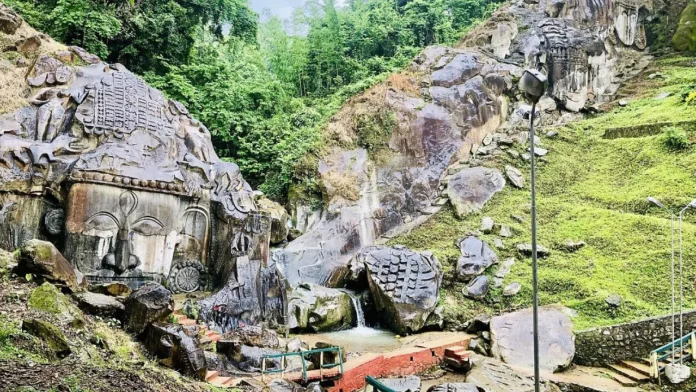Renowned as one of the country’s most enigmatic religious sites, Unakoti mesmerizes visitors with its towering rock-cut sculptures, ancient temples, and a rich tapestry of folklore that transcends the bounds of time. As pilgrims and history enthusiasts flock to this mystical destination, the legend of Unakoti continues to captivate the imagination, weaving a narrative that blends myth and history in equal measure.
Unakoti, which translates to “one less than a crore” in Bengali, derives its name from the fabled tale of its creation. According to local folklore, the site is believed to have been the abode of Lord Shiva and his entourage of gods and goddesses. Legend has it that during a celestial journey, Lord Shiva, accompanied by one crore (ten million) gods and goddesses, halted at Unakoti for a night’s rest. He instructed his divine companions to awaken before dawn and proceed with him to their destination. However, come morning, only Lord Shiva arose, leaving the rest in a state of slumber. In a fit of divine fury, Shiva cursed his companions, turning them into stone sculptures that adorn the landscape of Unakoti to this day.
At the heart of Unakoti lies a sprawling complex adorned with colossal rock-cut sculptures and intricately carved reliefs dating back to the 7th to 9th centuries CE. The site serves as a testament to the artistic prowess of ancient craftsmen who painstakingly chiseled these masterpieces into the rocky terrain. The most prominent among these sculptures is the imposing image of Lord Shiva, known locally as “Unakotiswara Kal Bhairava,” standing at a towering height of approximately 30 feet. Flanked by an array of deities and celestial beings, the monolithic figure of Shiva exudes an aura of divine majesty, evoking a sense of reverence and awe among visitors.
As visitors traverse the labyrinthine pathways of Unakoti, they encounter a myriad of sculptures depicting gods, goddesses, and mythical creatures, each imbued with its own symbolic significance. From the serene visage of Goddess Durga to the fierce countenance of Lord Ganesha, every sculpture tells a story, weaving together the tapestry of Hindu mythology and folklore. The site also features ancient rock-cut water reservoirs, believed to have served as sacred bathing pools for pilgrims and ascetics during ancient times.
Beyond its religious significance, Unakoti holds immense archaeological and historical value, offering insights into the cultural heritage of the region. The site bears testimony to the flourishing artistic tradition that thrived in ancient Tripura, serving as a beacon of creativity and craftsmanship. Scholars and historians continue to unravel the mysteries enshrouding Unakoti, delving into its rich tapestry of inscriptions, sculptures, and architectural marvels in a bid to unearth the secrets of its past.
Despite its cultural and historical significance, Unakoti remains relatively lesser-known on the tourist map, overshadowed by more popular destinations in India. However, efforts are underway to promote the site as a heritage tourism hotspot, drawing attention to its intrinsic beauty and historical allure. The Government of Tripura, in collaboration with various stakeholders, has initiated measures to develop infrastructure, enhance visitor amenities, and raise awareness about the cultural significance of Unakoti, thereby positioning it as a must-visit destination for travelers seeking a glimpse into India’s rich cultural legacy.
In addition, Unakoti stands as a testament to the timeless allure of India’s cultural heritage, beckoning travelers on a journey of discovery and enlightenment. From its towering rock-cut sculptures to its captivating legends, the site offers a glimpse into a bygone era, where gods walked the earth and legends were born. As visitors traverse the hallowed precincts of Unakoti, they embark on a pilgrimage of the soul, delving into the mysteries of the past and forging a deeper connection with India’s vibrant tapestry of faith and folklore.




